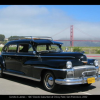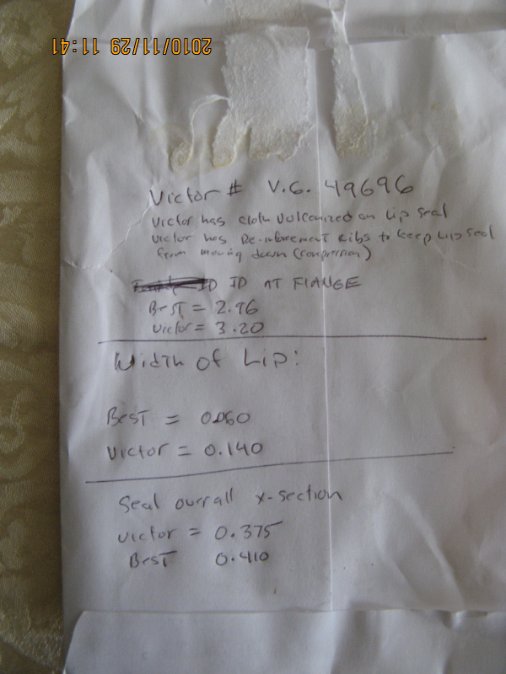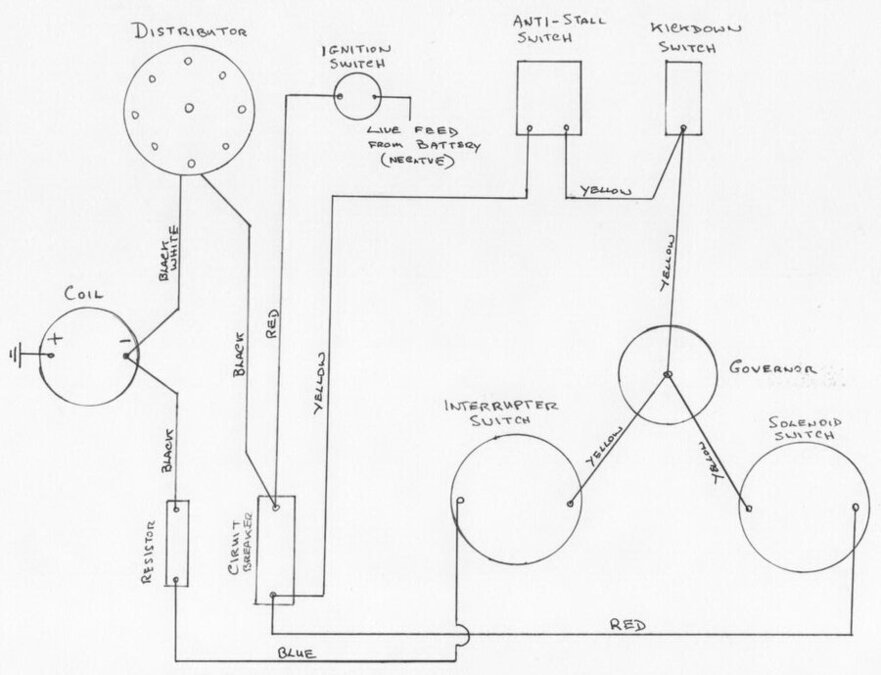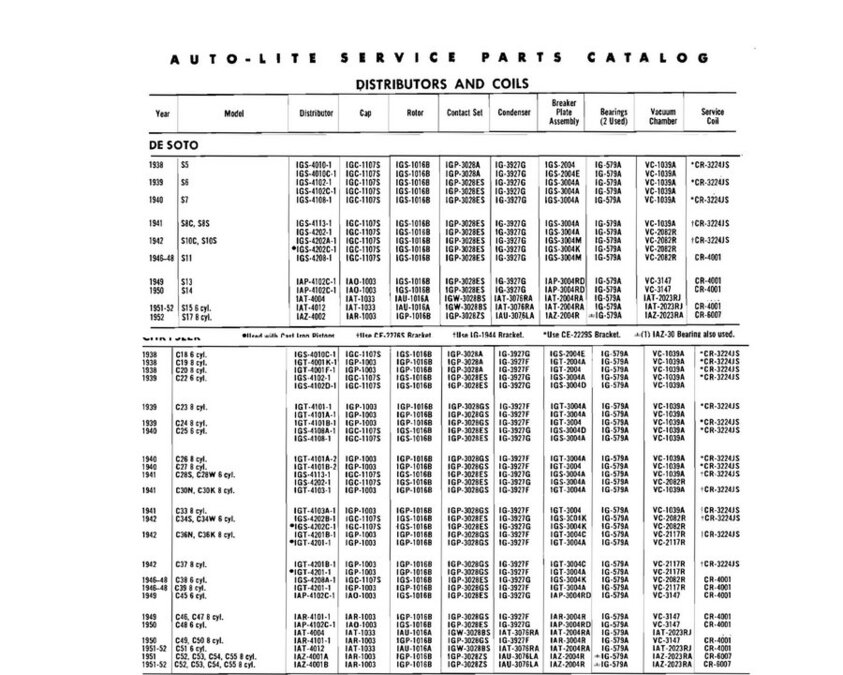-
Posts
1,923 -
Joined
-
Last visited
-
Days Won
23
Content Type
Links Directory
Profiles
Articles
Forums
Downloads
Store
Gallery
Blogs
Events
Everything posted by James_Douglas
-

Anyone expressed interest in your cars when you pass?
James_Douglas replied to knuckleharley's topic in P15-D24 Forum
I can relate. We have no kids and our nieces and nephews have no real interest in old cars, or old Jukeboxes, or anything else. We have discussed what to do with our stuff as well. I like the concept, if I could ID one when the time comes to find some young kid with a real interest in this stuff and see to it he/she got it all like a lightening bolt out of heaven ---with no previous idea that they would get anything. As someone who had his dad die when he was 9 and mother at 24, I am well aware how short our time here really is. The one thing I have been doing the last few years is tagging and organizing all the spare parts and special tools. All with those little white tags so that people know which car they go for, is they are used or NOS and the like. I must have $10K of parts! James. -
My 251 leaks and drives me nuts. It leaked from new. I have changed the seal three times. I asked Best Gasket what is the shaft range the seal is designed for and they said they do not have that. ??? The crankshaft I have when I put it in was checked at the crankshaft shop. It was NOS at the time. One of my engines for the '49 convertible was rebuilt in 1963 by Automotive Engineering. It sat from 1968 to 2013. When I ran it it almost did not leak at all. I have a NOS MOPAR rear seal that was made by Victor. It is built completely different from the one Best sells. The seal surface of it is three or four times as wide and it has a Vulcanized material over the rubber. I think the Best modern seals do not work well. The next engine I build, I am going back to the rope seal. I think the larger seal too shaft area will provide a better seal. My 2 cents worth. James
-

New Member, with Handling and Drivability Questions
James_Douglas replied to Jfleming's topic in P15-D24 Forum
Welcome. I had a good friend that purchased the same car in 1985. I rebuilt the entire front end for him so I have some idea of how this car works. I would say the first thing to do is to get some new tires. Go to Diamond Back Tire and look at their new Auburn Tire. Once that is done take it into a front end alignment shop and have then set the camber and castor and toe. Have them check the King Pin Inclination even though it is not adjustable, this will tell you if anything is bent. The other thing I would do is read over all the stuff on the Chrysler Imperial Website on the coaxial power steering. Sometimes that can cause people issues. If all of that checks out OK, then pull the king pins and see how much play is in them. Also, MAKE SURE that if the Master Parts Book shows they used a needle bearing in the upper of the spindle that your has that and not a bushing. Read my threads on my '49 Desoto to see why. Good luck. James -
I am planning on using a serpentine belt. I also will be using the Clark Electric Water pump so that I can run the pulley to the compressor to a big alternator with an idle wheel. A radiator fan on the inside, with two fans or perhaps 4 fans. That way if one goes, I still have some cooling. The electric water pump is a very good idea as it will maintain flow no matter what the engine speed is. I should have it all mocked up by Christmas. I would not mind some good shots of the A/C mounting bracket. James
-
I got a set from Eaton Detroit Spring for my 1947 Desoto. They are working fine. They had the prints for both the normal spring and the heavy duty spring. I went with HD springs. I will also be ordering a new set of coils for the front of the '49 soon from them. James
-

How to remove control arms on 48 DeSoto
James_Douglas replied to MarcDeSoto's topic in P15-D24 Forum
Marc, All my parts are 80 miles away in my place out of town... Do you still have your lower control arm pivot bar and bushings handy? If so, could I get you to do something for me? Stick one of the bushings in a bench vise. Then screw in the pivot bar about half way into it. Mark with a ruler the distance to any fixed point like the rear of the busing in the vise or the side of the vice. Then turn the pivot bar one complete turn into the bushing and measures how much it moved into the bushing. The do a second turn and measure and then a third. What I want to know is how much does the pivot bar move per one turn. Three turns dived by the distance will give an average per turn to see if it is even. What I want to do in the next month or two is to see if I can screw in my lower control arms on the 1949 Desoto CV to move the lower control arms forward relative to the upper. I did not have the tool when I did mine, so I mocked up a board and steel with holes to make sure I got it centered. What I want to do now is to UN-center it to give it more Caster so that I can bring the eccentric adjuster back to something more centered in the upper control arm. I had to move them all the way back to get my -0.5 and -1 Caster. The question is how much movement does one get for one turn on that pivot. With measurements and some math I may be able to get a good guess as to how many turns I need to increase the castor. Thanks, James -
FYI Frank, or rather his old company since he is long dead, has three of those supports. https://www.ebay.com/itm/1941-1950-Plymouth-Dodge-DeSoto-Chrysler-STEERING-KNUCKLE-SUPPORT-NOS-MoPar-/402293513426 I would double check my master parts books and talk with them to confirm then buy a set.. On my 1949, I had to replace one as it had a slight tweak in it and that would toss out the alignment no matter what. One big pot hole can do that on the supports. James.
-
The forging numbers sometimes match the MOPAR part numbers and sometimes not. I have also seen forging numbers that were close but not exactly the same as those in my Hollander Interchange. The Hollander shows for 1941 to 1950 Plymouth as: 856164 Right and Left or 1119642 Right and 1119643 Left. I would hunt on ebay for a NOS support and if you can find one that is tagged with the correct MOPAR part number...see if you can cross reference its forging number. I would also buy it so I could check it against what you have on the car. One should take a good long time to run this down as if there is a mix and match in these parts the front end alignment may not come out correct. As a last resort, I would get a NOS support and a NOS Spindle that you can confirm is in fact correct and take measurements from them and apply them to what you have. A good machine shop could open up the support hole to match the NOS parts you ran down. Then you can move forward and have a set of spares should you every need them. In particular if it is one of the 856164 supports that are same for left and right. James
-
The bearings show up all the time on ebay. Just find some numbers and go hunting. James. Also, as far as I can tell, the desoto and chrysler king pin kits, for the NOT LWB cars are the same just locate a kit with uppers that have bearings. James
-
Ok, If the hole in the Support is too small, then something is really wrong. What are the numbers cast into the support? James
-
Oooohhhhh, You are talking about the TAPERED LOCKING PIN not the king pin. Somehow I missed that point. They are tapered with a flat spot and on one side they come out one way and on the other side they come out the other. Make sure you are measuring the correct end. I wrote in my Master parts book the following when I did the Big Desoto some 15 years ago: "Passenger side is driven from the rear and comes out the front" "Drivers side is driven out from the front and comes out the rear". That was 15 years ago. Someone may want to comments if it is different on things other than a DeSoto. These pins are a one way only pin with a slight tapper. They should start just fine and tighten up as they are driven home with a brass drift. James
-
I am not so sure I agree with that. When I talked with both Flaming River and Unisteer... They said their racks are NOT for cars over 3500 pounds....makes me wonder...
-

Pulling my hair out on my '49 Desoto
James_Douglas replied to James_Douglas's topic in P15-D24 Forum
My 1947 Desoto steering as good or better than many modern cars. Of course the 139.5 inch wheelbase does not hurt... And like I said on the last test run, all the twitchy went away. I think it is a case of needing to test and "tune" and test and tune to get it dialed in. James. -
If one keeps an eye out on ebay... Some of the reamers for the king pins come with an adapter that is used to press the bushings out. NEVER hammer on a bushing or a spindle use a mandrel and if need by have a general machine shop make you one. I have then for both the 0.7xx size and the 0.9xx size. I also am using bearings in the upper as opposed to bushings. See my thread on the steering PITA on my 1949 Desoto... James.
-
If you have a set of pins in the 0.9xxx range then you have a set that is for the MOPAR Large Wheelbase cars like my 1947 Desoto Suburban or the few Chrysler, Desoto, Plymouth and Dodge Limo's. Someone put the wrong parts into your box. Send it back. The 1946 to 1953 MOPAR all cars Master Parts Book show the "kit" as 933-435 for 1939 to 1954 Plymouth. Now that said, I have confirmed that the Parts Books have errors or omissions on the front end parts for 1949 and 1950. Remember that it was a late and by accounts rushed change from the warmed over 1942 models that 1946 to February 1949 models represent. They also changed things a lot for 1951. So in many ways information was played with fast and loose for the si months of actual 1949 production and the 12 months of 1950. I have confirmed that some spindles were used on 1949 and 1950 cars that are NOT in the master parts books. I suspect a running change or a supplier issue. Almost all but the LWB cars for MOPAR during those years used a king pin that was in the 0.7xxx size. One thing. I would strongly consider using torrington needle bearings in place of the bushing in the upper. It will steer MUCH nicer with them. See the attached old article. Note that the tool he made was for something other than a MOPAR so size a tool as appropriate. One note. The instructions in the sheets from MOPAR with the kits day to remove all end-ply using the shims on the thrust bearings. Do NOT do that. Make sure that you have between eight and ten thousands of end-play. I found a mid-1950's tech note on the subject. Binding was an issue. James King_Pin_Bearings.pdf
-

Pulling my hair out on my '49 Desoto
James_Douglas replied to James_Douglas's topic in P15-D24 Forum
I wanted to circle back and report on the full road test. I managed to get out of SF and up to the house and get the car off the rack and drive it a good distance. To recap. The car now has torrington needle bearings in the upper of the king pins in place of the bushings. I also managed to get -0.5 and -1 on the castor. The camber and toe are all within the published specifications. The car was taken down a two lane back country road, some of which was relatively new pavement and some of it was bumpy. At 55 MPH the car steered very straight and did not wander like it has been. It also self centered after a turn like one would expect. I then ran it down the Interstate on a very long straight stretch. I ran the car up to 70 MPH and the car did not twitch nor wander like it had. If I let go of the steering wheel, it is slowly drifting to the left, but it is not pulling to the left. One little finger on the wheel and it does not drift. I have the adjuster cam as far to the rear as they will go. I am sure it is probably binding on the upper control arm which is warned about in the service manual. I will need to pull them back a bit. What I am thinking I am going to do is to drop the lower control arms at the inner pivots. I will take the front bushing out of the control arms and turn the pivot bars clockwise (looking from the front of the car) one or two turns. This will screw the pivot bar deeper into the rear bushing. Then I will screw in the removed bushing. What this will do is shift the lower control arms forward causing more tilt of the king pins. This will increase the castor so that I can bring the adjuster cam closer to the center of the top control arm. There is a service note someplace that warns that if you do not use the miller tool that you can get the lower control arm pivot installed incorrectly and affect the castor. I am going to use that logic to try and get myself some more positive castor ability. Since the needle bearing and the about 1.5 more degrees of castor did the trick, I know I am on the right track to getting this car to steer good. I have kept all the other adjustments the same on purpose so that I can know what is going on. Once I can get both sides to -0.5 degrees castor and the cam about middle of the range between the two ends of the upper control arm...then I will play with the camber to deal with the slight drift to the left, make sure the steering box (all new parts) is dialed in with the spring scale for worm and roller and get the worm gear (steering wheel) perfectly centered on the high spot. This last item is going to take some work. It turns out that there are 3 published lengths for the drag link. I have confirmed that fact with Rare Parts. It seems there was some supply issues back in the day as 1949 was a late start model wise. I had set the tie rods to the exact same length as one is supposed to do with equal length tie rods...but the steering is a little off center. The "correct" answer is to set the drag link length so that the wheels are straight ahead with the tie rods at equal length. That is how this design is supposed to work. The problem is that for 1949 the drag link does not have adjustable ends. So I will either have to take careful measurements and have Rare Parts make me a drag link the correct length or I will have to set the tie rods to not equal lengths. That has implications for toe out on turns not being correct. Did I mention how much fun this is? Best, James. -
Anyone recently buy a new MIG or multipurpose welder? I really need to go get one, but I am torn between spending $3K for a Lincoln or Miller or $999 for a Harbor Freight... Thoughts? James
-
Back when seat belts first came out there were instructions in the retrofit kids that specifically said to NOT install any belt to the frame in any way, but only to the body. James
-

Old Mopar Flat Head Engine Oil & Additives Poll....
James_Douglas replied to keithb7's topic in P15-D24 Forum
I use straight 30 or 40 without any additives. The ZINC thing is in my opinion much ado about nothing. Years ago I talked with someone who does the testing of engine oils for a very large organization. They set the oil standards. They have a room of engines that are the most blueprinted and checked engines in the world. They have to be to detect what oil does or does not due to them. They have found no wear issues with or without zinc in the engines. Period. They have found that a number of camshafts in the 1990's, when a LOT of cam production moved out of the USA, hard issues with Rockwell Hardness on the lobes. I suspect that proper hardness treating of cams and lifters drove much of the speculation about Zinc. I could not find one single "hard science" document on the subject. A lot of opinion, but nothing approaching the folks I know that actually ran engine with and without zinc and measured the wear differences. My 1947 Desoto Suburban engine I built 15 years ago. It has about 70K miles on it. I run it in the Hills of San Francisco and the Interstate to my place out of town at 70 MPH. The car is about 5000 pounds. I looked at the cam a while back with the side covers off and a bore scope. The cam was NOS when it went in. It looks fine with no evidence of advanced wear. I never used any zinc. James. -

1949 fluid drive semi automatic transmission
James_Douglas replied to Eddietoronto49's topic in P15-D24 Forum
Eddie, The odds are that you shifted something in the engine bay that caused the issue when you were doing the freeze plugs. I would call one of the wiring companies that make harnesses and get a transmission harness which is separate from the main harness. Then you know you have all good new wire to the trans-engine connections. Along with that take the advice on cleaning the governor and all the other parts. If that does not fix it then I would look to the linkage adjustments. If that does not do it then you have to follow the EXACT process in the booklets on the Imperial Site to run down the problem. That is a PITA but it works every time to find the issue. James. -
If it were me...I would roll back and use a 1946 to 1948 Distributor. More parts and it works just the same. In my 1949 Desoto I use the correct IAP as it is show car. I also put the same distributor in my 1947 Desoto as I wanted the same dizzy in both. I have a couple of sets of pertronix for my cars, but still have not gotten around to installing them. I have the 3-speed with BW overdrive in the '47 and I have to figure out the wiring for the resistor for that. I am attaching something I got from pertronix years ago which is what Don posted for anyone that wants it. Also attached is the Desoto and Chrysler Page from my 1952 Autolite Cat. James.
-
The bushing I have in my NOS MOPAR kits ARE NOT OILITE! I will say it again, get a kit with the upper that has the tornington bearing and get the special reamer that the upper is set up for THE BEARING and the lower is for the bushing. I have on in my tool box. It is a FIXED reamer specifically for king pins. They show up on ebay. Find one. I honed them the first time around at my machinist with a new sunnen hone while it was being bathed in oil in his fancy sunnen machine. The final fit was as good as a close tolerance bearing. The problem is that it was TOO GOOD and grease could not get around it and it galled on the upper outer side when in use. Made for hard steering and wander. The FACTORY MASTER PARTS BOOK shows a bearing top - bushing bottom for 1949. Use them. James
-
You should go read the threads on my 1949 Desoto Convertible steering issues. I assume that since the thing is apart that you will buy a kit and replace the pin and the bushings-bearings. The three take away's from my experience are: 1. The service book says to "remove all endplay" with the shims on the thrust bearing. Later books warn that one needs 0.008 or it can bind. Mine is at 0.0085. 2. For 1949 even the standard Desoto's, as opposed to the long wheelbase cars, used a torrington needle bearing in the upper of the spindle. Not a bushing. I can attest to the great difference this makes given the negative castor settings of 1949. I would not use anything other than the upper bearing as it steering better with it. 3. Use some anti-seize compound on the pin so that the next poor guy who needs to get the pin out will not kill himself.
-
If one goes an gets a copy of the AMA Specifications for their car...it lists the spring specifics. Like my 1949 Desoto. It shows the front springs as made with "Amola" Steel. The Free Length is right is 15-5/8 inch and and the left is 15-13/16 inch. "Length Under Curb Weight" is 11 inches. For my 1947 Desoto I had Eaton make me a set of new rear springs. They had the blueprints for both the stock and commercial heavy duty. They emailed me both the spring load and the spring rates for both. So far a year later not issues with the rear springs. James.
-
I have run my 5000 pound 1947 Desoto for 15 years with a 251 engine, a fluid coupling, and the three speed stick with BW overdrive. I have used the 4.1 gears and the 3.9 gears. I go down the highway at 65 all the time. On hills, I usually have to drop it out of overdrive. The car is just to heavy compared to most running the six. As far as I know there is no overdrive that was made to mate with the M5/M6 transmission. I do know you can go get a gear vendors OD unit and splice it into the driveshaft. At a cost of about $6K by the time you are done. I know guys with Packard's and the like from the 1930's that have done that. James






